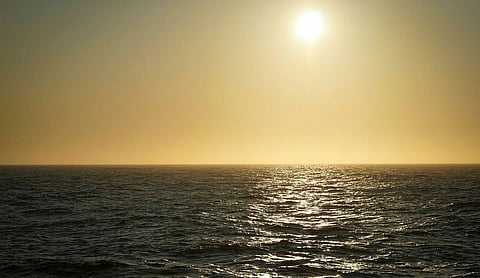

Seawater temperatures in Northern Norway last August reached 18 degrees celsius, the highest ever recorded.
Photo: Stine Hommedal / HI (Institute of Marine Research)
Unprecedented ocean temperatures in Northern Norway during the summer of 2024 triggered a "explosive" surge in sea lice, according to new findings from Norway's Bjerknes Centre for Climate Research.
In August last year, a marine heatwave developed around Lofoten, lasting three weeks and raising sea surface temperatures to 18°C, around four degrees above the seasonal average - the highest temperature recorded since monitoring by the Norwegian Institute of Marine Research began in the 1930s.
A figure showing the extent of the marine heatwave on 15 August 2024, the date of maximum intensity.
Illustration: Silvana Gonzalez / HI (Institute of Marine Research)
The event, the researchers say, was due to a rare combination of weather conditions. Calm winds, clear skies and continuous sunlight in the Arctic summer prevented mixing in the water column, allowing surface waters to heat rapidly.
“That’s the perfect setup for a marine heatwave. When there’s no wind, the water column layers don’t mix like they do when it’s windy. And when there are no clouds – and the sun shines nearly around the clock – the surface layer of water heats up quickly,” said marine researcher Silvana Gonzalez, in a Bjerknes news release.
Silvana Gonzalez researches marine heat waves along the Norwegian coast.
Photo: Tori Pedersen / Bjerknes Center
An additional contributing factor to the heatwave was an atmospheric phenomenon called the North Atlantic Oscillation, where extreme pressure differences occurred in the North Atlantic. “We say that NAO is positive when the difference between the low pressure over Iceland and the high pressure over the Azores is larger than usual. In July and August 2024, that pressure difference was the highest ever recorded since measurements began in 1948,” Gonzalez explained.
While the heatwave eased in Lofoten by late August, the researchers say elevated temperatures persisted in the southern Barents Sea into September.
The aquaculture industry in northern Norway reported severe impacts. According to salmon lice expert Anne Dagrun Sandvik, lice counts in fish farms began rising sharply at the end of July.
“Even an increase of one degree has effect on salmon lice, and when it becomes 3–4 degrees above normal, as measured both at farms and our monitoring stations, the effect is very large,” Sandvik said.
Farmers are required to monitor lice and submit weekly reports to the Norwegian Food Safety Authority. Data from Troms to Finnmark showed what Sandvik described as an "explosive" increase. She said that numbers, which typically stay below 2.5 million adult female lice during summer, doubled within weeks and reached an estimated 20 million in early October. Researchers also calculated that farms north of Kvaløya produced 105 million louse larvae per hour at the height of the outbreak.
The researchers explain that the life cycle and reproduction rate of sea lice accelerates as temperatures increase. The lice also become more aggressive and attach more easily to salmon in warmer conditions, Sandvik explains.
“The explosion of salmon lice is just one example of how marine heatwaves can affect marine ecosystems, fisheries and aquaculture in profound ways,” Gonzalez added.
Marine heatwaves have been increasing in frequency and intensity in Norwegian waters over recent decades. The Bjerknes Centre says it aims to improve understanding of the regional drivers of such events and to develop early-warning capabilities to help the aquaculture industry and others prepare for their impacts.
The status of sea lice levels in Norway's different aquaculture production areas is updated weekly on the Marine Research Institute website.
